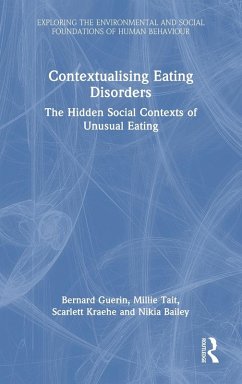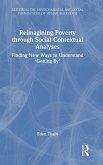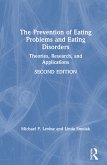Bernard Guerin, Millie Tait, Scarlett Kraehe
Contextualising Eating Disorders
The Hidden Social Contexts of Unusual Eating
Bernard Guerin, Millie Tait, Scarlett Kraehe
Contextualising Eating Disorders
The Hidden Social Contexts of Unusual Eating
- Gebundenes Buch
- Merkliste
- Auf die Merkliste
- Bewerten Bewerten
- Teilen
- Produkt teilen
- Produkterinnerung
- Produkterinnerung
This book rethinks the diagnosis and treatment of 'eating disorders' by putting the spotlight on their social and societal contexts, examining how these behaviours are shaped by the difficult life conditions of those suffering.
Andere Kunden interessierten sich auch für
![Reimagining Poverty through Social Contextual Analyses Reimagining Poverty through Social Contextual Analyses]() Eden ThainReimagining Poverty through Social Contextual Analyses198,99 €
Eden ThainReimagining Poverty through Social Contextual Analyses198,99 €![The Thin Woman The Thin Woman]() Helen MalsonThe Thin Woman198,99 €
Helen MalsonThe Thin Woman198,99 €![The Prevention of Eating Problems and Eating Disorders The Prevention of Eating Problems and Eating Disorders]() Michael P. LevineThe Prevention of Eating Problems and Eating Disorders199,99 €
Michael P. LevineThe Prevention of Eating Problems and Eating Disorders199,99 €![Dieting, Overweight and Obesity Dieting, Overweight and Obesity]() Wolfgang StroebeDieting, Overweight and Obesity199,99 €
Wolfgang StroebeDieting, Overweight and Obesity199,99 €![Everyday Applications of Psychological Science Everyday Applications of Psychological Science]() R. Eric LandrumEveryday Applications of Psychological Science75,99 €
R. Eric LandrumEveryday Applications of Psychological Science75,99 €![Digitalization and Learning as a Worlding Practice Digitalization and Learning as a Worlding Practice]() Ernst SchraubeDigitalization and Learning as a Worlding Practice198,99 €
Ernst SchraubeDigitalization and Learning as a Worlding Practice198,99 €![The Good Life The Good Life]() Graham MusicThe Good Life231,99 €
Graham MusicThe Good Life231,99 €-
-
-
This book rethinks the diagnosis and treatment of 'eating disorders' by putting the spotlight on their social and societal contexts, examining how these behaviours are shaped by the difficult life conditions of those suffering.
Hinweis: Dieser Artikel kann nur an eine deutsche Lieferadresse ausgeliefert werden.
Hinweis: Dieser Artikel kann nur an eine deutsche Lieferadresse ausgeliefert werden.
Produktdetails
- Produktdetails
- Verlag: Routledge
- Seitenzahl: 196
- Erscheinungstermin: 18. Juni 2024
- Englisch
- Abmessung: 240mm x 161mm x 15mm
- Gewicht: 464g
- ISBN-13: 9781032592688
- ISBN-10: 1032592680
- Artikelnr.: 70371143
- Herstellerkennzeichnung
- Libri GmbH
- Europaallee 1
- 36244 Bad Hersfeld
- gpsr@libri.de
- Verlag: Routledge
- Seitenzahl: 196
- Erscheinungstermin: 18. Juni 2024
- Englisch
- Abmessung: 240mm x 161mm x 15mm
- Gewicht: 464g
- ISBN-13: 9781032592688
- ISBN-10: 1032592680
- Artikelnr.: 70371143
- Herstellerkennzeichnung
- Libri GmbH
- Europaallee 1
- 36244 Bad Hersfeld
- gpsr@libri.de
Bernard Guerin is Professor of Psychology at the University of South Australia. His research and writing try to integrate what we know from the social sciences to provide a contextual view of all human behaviour, talking and thinking. Millie Tait is a Psychology Honours Graduate from the University of South Australia working in community services. She is interested in supporting people through their life situations labelled as 'mental health problems' without pathologising. Scarlett Kraehe is a Bachelor of Psychology (Honours) Graduate from the University of South Australia with an interest in gender and race theory. Nikia Bailey is a Psychologist holding a Master of Psychology (Clinical) from the University of South Australia.
1. Introduction
Part 1. Background to the 'eating disorders' behaviours
2. What the mainstream models say is happening with behaviours and
recovery?
3. What alternative models say is happening with unusual eating behaviours
4. What was our research about?
Part 2. The unusual eating behaviours of our nine collaborators
5. Adora's story: Becoming a "good girl"
6. Gabby's story: A ballerina's sacrifice
7. Diane's story: Sisters and solitude
8. Bianca's story: Shrinking for love
9. Erica's story: Mother knows best
10. Sally's story: Serious journos talk about lip filler
11. Fiona's Story: The weight of expectations
12. Courtney's story: Out of the frying pan into the fire
13. Katrina's story: What goes on behind closed doors
Part 3. What was learned about unusual eating behaviours put in context?
14. Summary 1: The diversity of life pathways
15. Summary 2: What shapes the 'eating disorder' behaviours and what leads
to recovery?
Part 1. Background to the 'eating disorders' behaviours
2. What the mainstream models say is happening with behaviours and
recovery?
3. What alternative models say is happening with unusual eating behaviours
4. What was our research about?
Part 2. The unusual eating behaviours of our nine collaborators
5. Adora's story: Becoming a "good girl"
6. Gabby's story: A ballerina's sacrifice
7. Diane's story: Sisters and solitude
8. Bianca's story: Shrinking for love
9. Erica's story: Mother knows best
10. Sally's story: Serious journos talk about lip filler
11. Fiona's Story: The weight of expectations
12. Courtney's story: Out of the frying pan into the fire
13. Katrina's story: What goes on behind closed doors
Part 3. What was learned about unusual eating behaviours put in context?
14. Summary 1: The diversity of life pathways
15. Summary 2: What shapes the 'eating disorder' behaviours and what leads
to recovery?
1. Introduction
Part 1. Background to the 'eating disorders' behaviours
2. What the mainstream models say is happening with behaviours and recovery?
3. What alternative models say is happening with unusual eating behaviours
4. What was our research about?
Part 2. The unusual eating behaviours of our nine collaborators
5. Adora's story: Becoming a "good girl"
6. Gabby's story: A ballerina's sacrifice
7. Diane's story: Sisters and solitude
8. Bianca's story: Shrinking for love
9. Erica's story: Mother knows best
10. Sally's story: Serious journos talk about lip filler
11. Fiona's Story: The weight of expectations
12. Courtney's story: Out of the frying pan into the fire
13. Katrina's story: What goes on behind closed doors
Part 3. What was learned about unusual eating behaviours put in context?
14. Summary 1: The diversity of life pathways
15. Summary 2: What shapes the 'eating disorder' behaviours and what leads to recovery?
Part 1. Background to the 'eating disorders' behaviours
2. What the mainstream models say is happening with behaviours and recovery?
3. What alternative models say is happening with unusual eating behaviours
4. What was our research about?
Part 2. The unusual eating behaviours of our nine collaborators
5. Adora's story: Becoming a "good girl"
6. Gabby's story: A ballerina's sacrifice
7. Diane's story: Sisters and solitude
8. Bianca's story: Shrinking for love
9. Erica's story: Mother knows best
10. Sally's story: Serious journos talk about lip filler
11. Fiona's Story: The weight of expectations
12. Courtney's story: Out of the frying pan into the fire
13. Katrina's story: What goes on behind closed doors
Part 3. What was learned about unusual eating behaviours put in context?
14. Summary 1: The diversity of life pathways
15. Summary 2: What shapes the 'eating disorder' behaviours and what leads to recovery?
1. Introduction
Part 1. Background to the 'eating disorders' behaviours
2. What the mainstream models say is happening with behaviours and
recovery?
3. What alternative models say is happening with unusual eating behaviours
4. What was our research about?
Part 2. The unusual eating behaviours of our nine collaborators
5. Adora's story: Becoming a "good girl"
6. Gabby's story: A ballerina's sacrifice
7. Diane's story: Sisters and solitude
8. Bianca's story: Shrinking for love
9. Erica's story: Mother knows best
10. Sally's story: Serious journos talk about lip filler
11. Fiona's Story: The weight of expectations
12. Courtney's story: Out of the frying pan into the fire
13. Katrina's story: What goes on behind closed doors
Part 3. What was learned about unusual eating behaviours put in context?
14. Summary 1: The diversity of life pathways
15. Summary 2: What shapes the 'eating disorder' behaviours and what leads
to recovery?
Part 1. Background to the 'eating disorders' behaviours
2. What the mainstream models say is happening with behaviours and
recovery?
3. What alternative models say is happening with unusual eating behaviours
4. What was our research about?
Part 2. The unusual eating behaviours of our nine collaborators
5. Adora's story: Becoming a "good girl"
6. Gabby's story: A ballerina's sacrifice
7. Diane's story: Sisters and solitude
8. Bianca's story: Shrinking for love
9. Erica's story: Mother knows best
10. Sally's story: Serious journos talk about lip filler
11. Fiona's Story: The weight of expectations
12. Courtney's story: Out of the frying pan into the fire
13. Katrina's story: What goes on behind closed doors
Part 3. What was learned about unusual eating behaviours put in context?
14. Summary 1: The diversity of life pathways
15. Summary 2: What shapes the 'eating disorder' behaviours and what leads
to recovery?
1. Introduction
Part 1. Background to the 'eating disorders' behaviours
2. What the mainstream models say is happening with behaviours and recovery?
3. What alternative models say is happening with unusual eating behaviours
4. What was our research about?
Part 2. The unusual eating behaviours of our nine collaborators
5. Adora's story: Becoming a "good girl"
6. Gabby's story: A ballerina's sacrifice
7. Diane's story: Sisters and solitude
8. Bianca's story: Shrinking for love
9. Erica's story: Mother knows best
10. Sally's story: Serious journos talk about lip filler
11. Fiona's Story: The weight of expectations
12. Courtney's story: Out of the frying pan into the fire
13. Katrina's story: What goes on behind closed doors
Part 3. What was learned about unusual eating behaviours put in context?
14. Summary 1: The diversity of life pathways
15. Summary 2: What shapes the 'eating disorder' behaviours and what leads to recovery?
Part 1. Background to the 'eating disorders' behaviours
2. What the mainstream models say is happening with behaviours and recovery?
3. What alternative models say is happening with unusual eating behaviours
4. What was our research about?
Part 2. The unusual eating behaviours of our nine collaborators
5. Adora's story: Becoming a "good girl"
6. Gabby's story: A ballerina's sacrifice
7. Diane's story: Sisters and solitude
8. Bianca's story: Shrinking for love
9. Erica's story: Mother knows best
10. Sally's story: Serious journos talk about lip filler
11. Fiona's Story: The weight of expectations
12. Courtney's story: Out of the frying pan into the fire
13. Katrina's story: What goes on behind closed doors
Part 3. What was learned about unusual eating behaviours put in context?
14. Summary 1: The diversity of life pathways
15. Summary 2: What shapes the 'eating disorder' behaviours and what leads to recovery?








